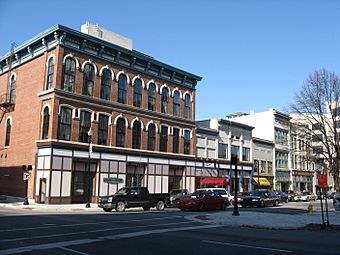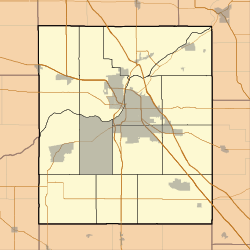Downtown Lafayette Historic District facts for kids
Quick facts for kids |
|
|
Downtown Lafayette Historic District
|
|

Courthouse Square in Lafayette, November 2009
|
|
| Location | Roughly bounded by 2nd, Ferry, 6th and South Sts., Lafayette, Indiana |
|---|---|
| Area | 19.9 acres (8.1 ha) |
| Built | 1825 |
| Architect | Multiple |
| Architectural style | Second Empire, Italianate, Art Deco |
| NRHP reference No. | 80000067 |
| Added to NRHP | November 28, 1980 |
The Downtown Lafayette Historic District is a special area in Lafayette, Indiana. It's like a time capsule that shows how the city grew from 1825 onwards. This district is important because it tells the story of how transportation changed over the years. From riverboats to canals and then to railroads, each new way of travel helped Lafayette grow. Many old buildings here still stand, showing us what life was like long ago.
Contents
A Look Back: How Lafayette Grew
Early Days by the River (1825-1842)
Lafayette began in 1825 because it was close to the Wabash River. A person named William Digby planned the town. Its first borders were the river on the west, Sixth Street on the east, and North and South Streets. The town grew as new ways to travel and trade became available.
The first big step for Lafayette was building a log courthouse in 1829. This showed that the town was becoming an important center.
The Canal Era (1843-1851)
A second period of growth started in 1843. This was when the Wabash and Erie Canal arrived. This canal was like an old-time highway made of water. It connected Lafayette all the way to Toledo, Ohio, and other markets on the East Coast.
With the canal, more people and goods came to Lafayette. The log courthouse was replaced with a brick building. Also, Fifth Street was made wider to create an open market area. This helped businesses grow even more.
The Railroad Boom (1852 Onwards)
Just ten years later, railroads came to town. This started the third and biggest period of growth for Lafayette.
- In 1852, the Lafayette & Indianapolis Railroad was the first train line to reach Lafayette.
- In 1853, the New Albany and Salem Railroad (later called the Monon Railroad) arrived. It followed Fifth Street.
- In 1854, the Wabash Line cut across the southeast part of the city. It crossed Main Street at Eleventh Street.
The railroads were a game-changer! They made it much easier and faster to send goods and travel. This helped Lafayette's businesses reach many more places. You can still see buildings from this time, like the Hatcher Building (1865), the Milwaukee Block (1866), and the Perrin Building (1877). Many other buildings along Main Street also show how much the town grew during the railroad boom.
Important Buildings in the District
The Downtown Lafayette Historic District has many old and important buildings. They show the different styles of architecture from the past. Here are some of them:
- 1860, River City Market, 102-112 North Third Street
- 1865, Hatcher Building, 10 North Third Street
- 1866, Milwaukee Block, 502-518 Main Street
- 1870/1914, Oppenheimer Building, 400 Main Street
- 1877, Perrin Building, 332 Main Street
- 1881-1884, Tippecanoe County Courthouse, Courthouse Square
- 1890, Hirsh Brothers Building, 427 Main Street
- 1892/1913, Murdock Building, 226 North Sixth Street
- 1907, Heiremans Building, 219 Main Street
- 1910, O’Farrell Building, 408-414 Main Street
- 1910, Sharp Block, 516 Main Street
- 1912, Robertson Building, 336-340 Main Street
- 1915, Fowler Hotel, 407 Ferry Street
- 1917/1918, First Merchants National Bank, 216 Main Street
- 1918, Lafayette Life Building, 200-206 Main Street
- 1926, Lafayette National Bank, 337 Columbia Street
- 1931, U.S. Post Office Building, 301 Ferry Street




